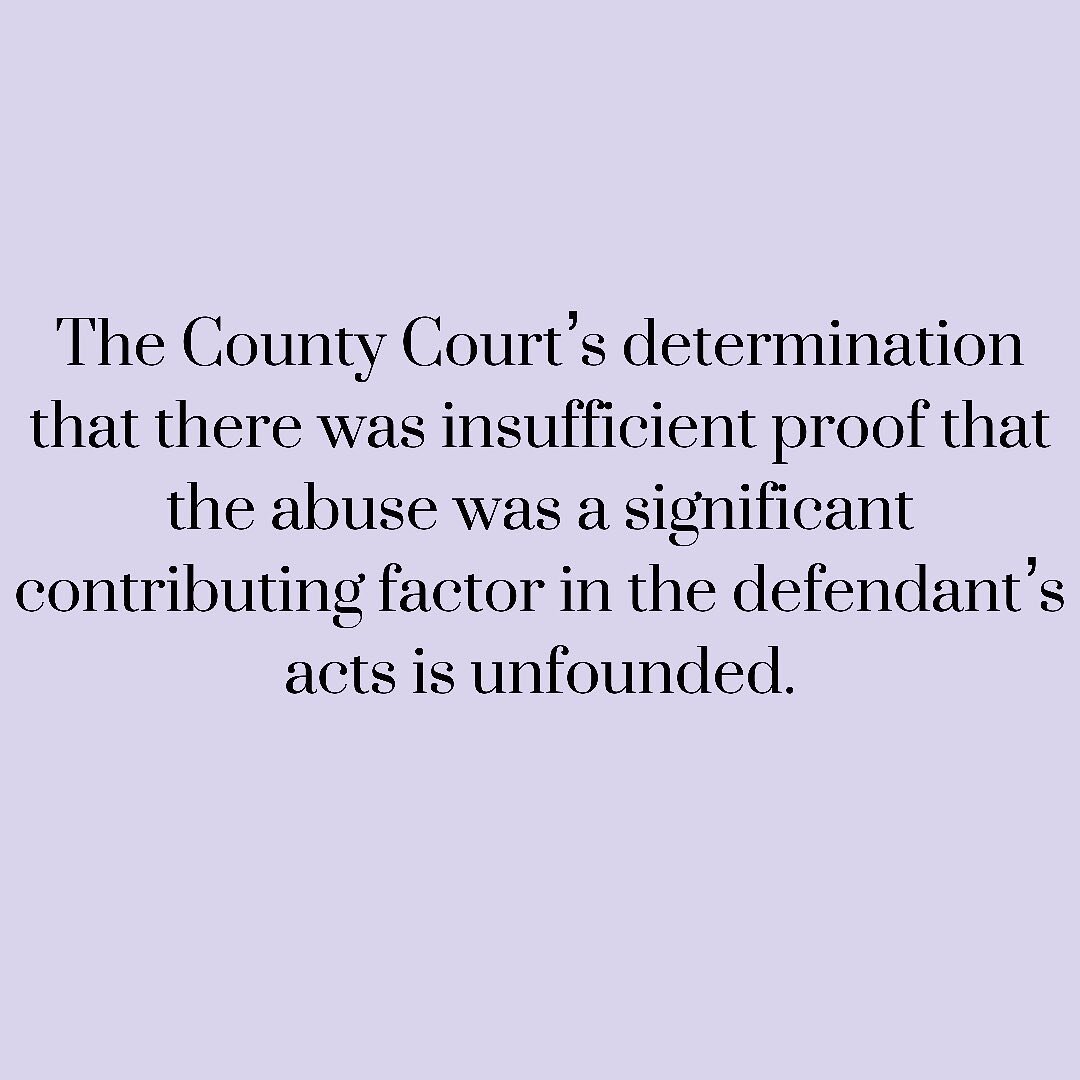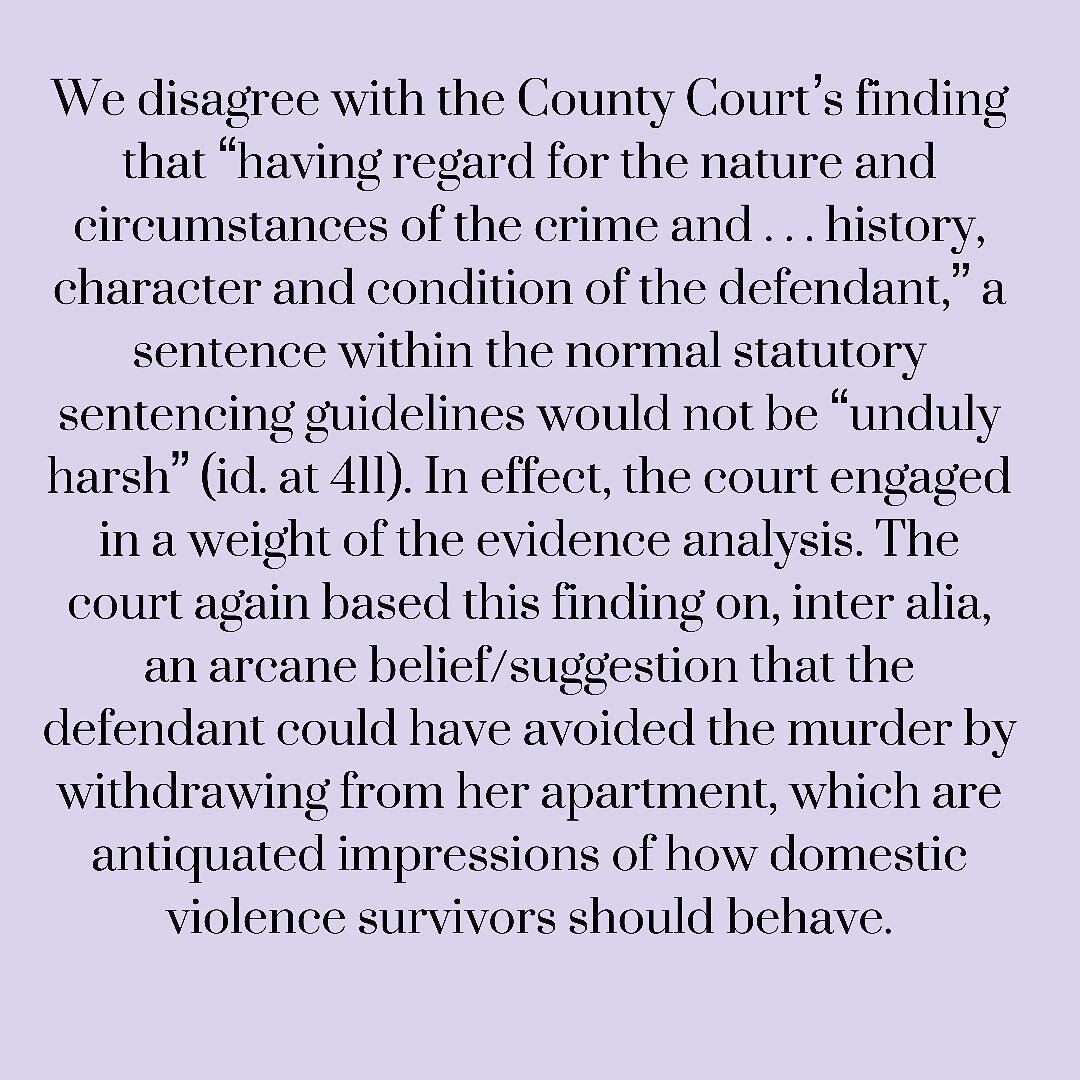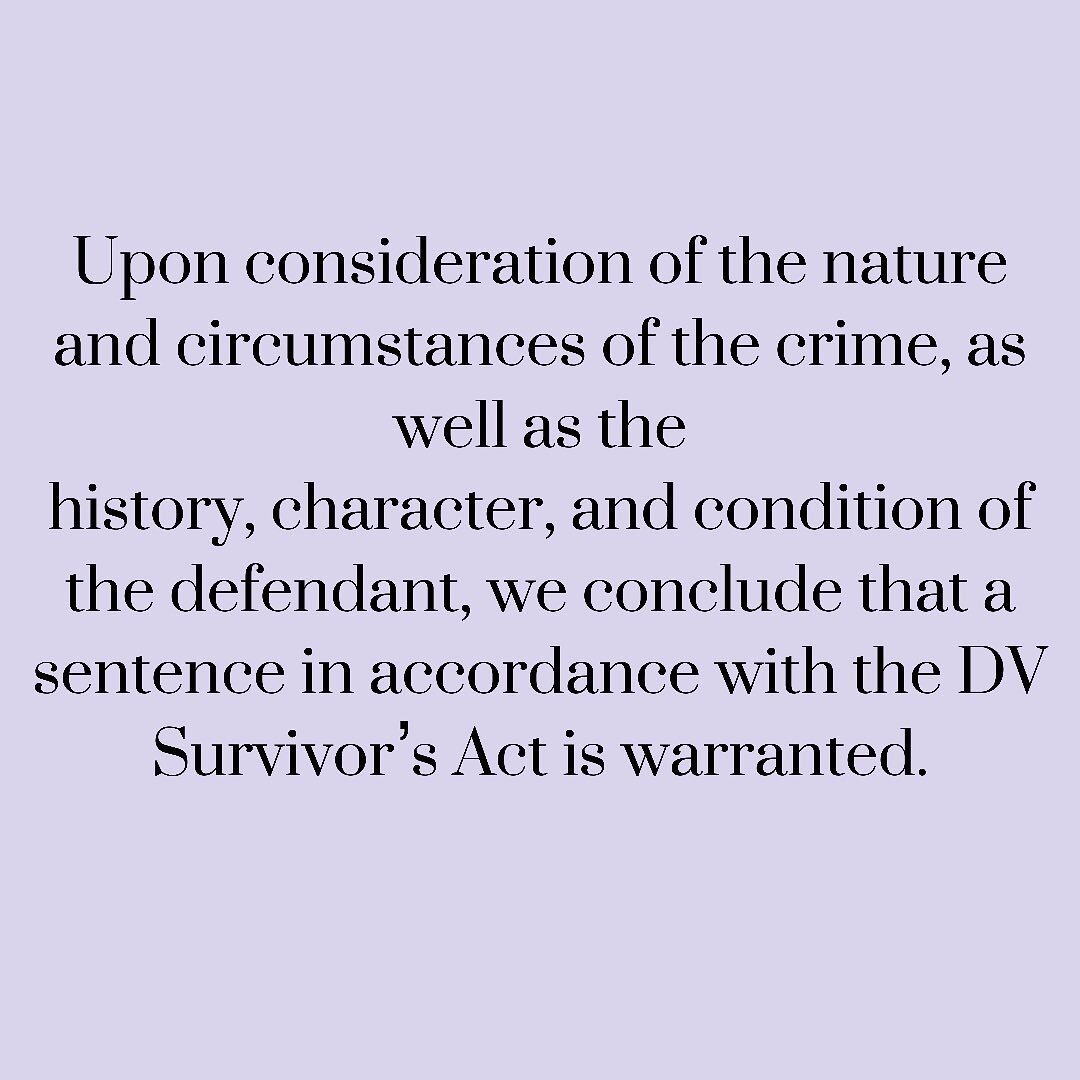NIKKI’S APPEAL
On Thursday, April 22, 2021 Nikki’s appeal was argued in front of the NY State Supreme Court’s Appellate Division (Second Department) by her pro-bono appellate team with Sullivan & Cromwell, LLP. You can watch the oral arguments here: http://wowza.nycourts.gov:1935/ad2/myStream/playlist.m3u8
Finally, in June 2021, the Court came back with their decision: Nikki should have been sentenced under the DVSJA (see point 5 below), and they chose to reduce her original sentence of 19-years-to-life to a determinate sentence of 7.5 years + 5 years parole. Her new release date is in 2024. In their decision, the Court wrote:
The Points of Appeal:
Although the Second Department only ruled on point #5, Nikki’s appeal outlines a wide breadth of ethical and legal errors. As advocates for Nikki, this is our attempt to explain the points of her appeal in layman’s terms. The description below was not in any way prepared by Nikki’s counsel and is not intended to be anything other than a non-lawyers’ description of the legal proceedings.
1. The Trial Court’s Disqualification Of Defense Counsel Based On A Purported Conflict Of Interest Denied Addimando Her Constitutional Right To Counsel Of Choice
After 9 months on the case, Nikki’s original attorney Kara Gerry, a Dutchess County Public Defender, was unlawfully removed on the eve of the Grand Jury. Prosecuting ADA Chana Krauss purported that because a “critical witness” to the prosecution was once represented by the Dutchess County Public Defenders, Nikki’s counsel had an “unwaivable conflict” and should therefore be removed. This motion was approved by Judge Edward T. McLoughlin, putting Nikki at a significant disadvantage.
Addimando’s brief details four reasons why this violated her constitutional right, and why the Appellate Court should grant a new trial:
There was no conflict of interest, as the witness’ DWI charge was unrelated to Nikki’s abuse or actions.
Nikki’s attorney had no conflict — she had no relationship with the witness or his prior representation, and was not working in the Public Defenders office at the time of his representation.
Nikki validly waived any conflict, having had consulted with independent counsel and provided a knowing waiver that should have been honored.
Even assuming a conflict, the court erroneously failed to adopt less prejudicial and drastic remedies — such as appointing conflicts counsel to cross-examine the witness — before disqualifying Addimando’s counsel of choice.
As made clear in the amicus brief written by the Ethics Committee of the New York City Bar Association, the trial court depriving Addimando of her counsel was clear legal error, and an improper interpretation of the New York Rules of Professional Conduct.
It should be noted that the “critical witness” that presented this conflict was never called to testify in trial.
Watch a simple explanation of Appeal Point #1 in this IGTV video.
2. The Integrity Of The Grand Jury Process Was Compromised By The Prosecution’s Introduction Of False Hearsay Testimony
After Addimando’s fingerprints were not recovered from the gun, the prosecution investigated whether the gun had been wiped clean, including by asking the police lab to test for solvents. After multiple rounds of forensic testing, it was determined that the gun had not been wiped and no solvent was detected on the gun. (As reported from trial, Addimando was holding the gun so briefly she didn’t leave prints; only Grover’s fingerprints were found on the gun’s slide.) Ms. Krauss had this forensic information prior to Grand Jury.
Yet in front of the Grand Jury, the Prosecutor obtained testimony from a detective that said, “they told us that the gun was wiped down.” Knowing the testimony was false, Prosecutor Krauss chose to lead the detective through a series of questions where he claimed the gun had been wiped down with baby wipes.
This knowingly false testimony implied guilt —undermining Nikki’s credibility and self-defense justification.
Moreover, the detective’s testimony — “[t]hey told us that the gun was wiped down” and that “[t]hey told us that there appeared to be residue left over from it being wiped off” — was clearly hearsay.
After Nikki’s trial attorneys reviewed the Grand Jury minutes, they put in a motion to void the indictment and send the case back to the Grand Jury. When the trial judge addressed this in court, the prosecutor conceded that it was improper testimony:
“Court: “Can we agree that no witness should ever be saying I heard this?”
Prosecution: “Absolutely.
Prosecution: “[A]dmittedly, it may have been improper to come out in the grand jury.””
Even though this was all presented to the trial judge, he allowed the indictment to stand. If this point of the appeal is successful, however, it would invalidate Nikki’s conviction and previous indictment, kicking the case back down to a new grand jury.
Watch a simple explanation of Appeal Point #2 in this IGTV video.
3. The Trial Court Abused Its Discretion When It Rejected Addimando’s Exercise Of A Peremptory Challenge
The trial court denied Nikki her right to strike a juror of her choice, which could result in a reversal of her conviction.
As explained in the brief:
“Nothing is more basic to the criminal process than the right of an accused to a trial by an impartial jury.” People v. Neulander, 34 N.Y.3d 110, 112 (2019). “[B]y enabling each side to exclude those jurors it believes will be most partial toward the other side,” the peremptory challenge achieves the goal of impartiality. J.E.B. v. Alabama ex rel. T.B., 511 U.S. 127, 147 (1994). The ability to exercise a peremptory challenge is thus a “substantial right” of the accused, People v. Jabot, 93 A.D.3d 1079, 1081-82 (3d Dep’t 2012), and such challenges play a heightened role in cases where there is a substantial potential for juror bias, such as those involving domestic violence and sexual abuse. See Linn v. State, 929 ”
Nikki exercised a peremptory challenge well before jury selection was finalized or before any juror was sworn in. Judge McLoughlin’s rejection of her challenge was an abuse of discretion.
Watch a simple explanation of Appeal Point #3 in this IGTV video.
4. The Trial Court Erroneously Excluded Evidence Supporting Addimando’s Credibility And Her Justification Defense—The Central Issues At Trial
Prior to trial, Prosecutor Chana Krauss and Judge Edward T. McLoughlin suppressed significant evidence identifying Grover as Nikki’s abuser. This ruling paved the way for Prosecutor Krauss to develop her unfounded theory that there was no proof Grover had abused her, and therefore none of Nikki’s testimony was to be trusted.
The appellate brief makes several points:
The Court Erred by Excluding Evidence of Grover’s Pornhub Profile.
The jury was able to see images of Nikki in compromised, humiliating positions — bound, gagged, and naked — without any surrounding context as to who owned the account, and what the account owner wrote in descriptions and hashtags.
Yet the account name — Groverespect — and the biographical details on the account matched the evidence submitted at trial about Grover, including his name, age, gender, and interest in martial arts and cinematography.
This evidence was suppressed on grounds that the account couldn’t be verified, yet the brief details why this was more than enough evidence to verify a social media profile.
Even if the Evidence was Properly Excluded, the Prosecution’s Expert “Opened the Door” Through Misleading Testimony
Prior to trial, the prosecution’s expert Dr. Kirschner reviewed the complete Pornhub screenshots with the Groverespect user name and corresponding biographical information. Yet the prosecution, armed with the court’s evidentiary ruling, elicited testimony from Kirschner that the website’s pornographic photographs “didn’t say how it got there and whose website it was.” When the defense attempted to cross-examine Kirschner with the fact that the website identified a 29-year-old male named “Groverespect” as the person who uploaded the photographs, the trial court sustained the prosecution’s objection.
The Court’s Exclusion of this Evidence, Critical to Showing Abuse by Grover, was Highly Prejudicial.
As the brief states, “The exclusion of the Groverespect evidence went to the core issues at trial—including the prosecution’s vigorous and regular attacks on Addimando’s credibility regarding the violent and long-term abuse that she suffered at Grover’s hands. The excluded evidence identifying Grover as the person uploading the pictures of Addimando’s abuse would have supported Addimando’s credibility, undermined the prosecution’s attack, and aided in establishing Addimando’s justification defense. The jury should have been permitted to consider the excluded evidence and infer from the profile that (i) it was Grover who caused and then exposed Addimando’s cruel humiliation on Pornhub, and (ii) the prosecution wrongfully questioned both Addimando’s credibility and whether Grover committed any abuse.”
Watch a simple explanation of Appeal Point #4 in this IGTV video.
5. The Trial Court Failed To Follow The Express Statutory Commands Of Penal Law § 60.12, The Domestic Violence Survivors Justice Act.
Nikki should have been sentenced under the Domestic Violence Survivors Justice Act (Penal Law § 60.12). Judge Edward T. McLoughlin’s failure to do so was plain legal error.
The trial court’s failure to follow both the language and intent of the DVSJA is set out in further detail in the amicus brief filed by New York Senate and Assembly members who sponsored or supported the passage of the law:
“For the Act to have any meaning, judges must recognize the spirit of the law and actually implement it to help those victims of abuse and become involved in the criminal justice system as a result. The judge in Ms. Addimando’s case failed to do so, further victimizing Ms. Addimando and stripping the DVSJA of its intended effect.”
Sanctuary for Families — New York’s largest dedicated service provider and advocate for survivors of domestic violence, human trafficking, and related forms of gender violence — also submitted an amicus brief to support Addimando’s appeal, which was signed on by 11 other organizations. The aim of their amicus brief: “To address the knowledge gap inherent in the sentencing court’s analysis of Ms. Addimando’s abuse, and to provide an overview of the decades of scientific research into the far-reaching cognitive effects of coercive control, trauma bonding, and traumatic memory in order to improve understanding.”
They further stated:
“Ms. Addimando is the ideal candidate for reduced sentencing under the DVSJA. This reduced sentencing scheme recognizes that victims of abuse like Ms. Addimando are less culpable for crimes related to their abuse because of their altered cognition from (often years of) abusive control by their abusers; its aim is to ensure that punishments for victims of abuse are not ‘unduly harsh.’ However, the DVSJA cannot achieve this end when sentencing courts—like the court that sentenced Ms. Addimando—overlook the recognized psychological effects of domestic violence in their analysis. If Ms. Addimando cannot obtain relief under the DVSJA based on the abuse she suffered and a voluminous record of evidence supporting her story, Amici fear no victim’s claim will ever merit relief, rendering hollow decades of advocacy and the DVSJA itself.”
Addimando’s appellate brief detailed the legal error made in Judge McLoughlin’s application of the law:
“By imposing its own standard, plainly contrary to the statute’s text and purpose, the court created an illogical tautology—to be eligible for a reduced sentence for criminal conduct, Addimando must not have committed the crime in the first place....In other words, in the court’s view, Addimando could only be eligible for a reduced sentence if she had no choice but to shoot Grover, and thus was not a guilty of any crime in the first place.”
This was also highlighted in this independent Boston University Law Review essay:
“By any metric, Judge McLoughlin’s decision to deny Addimando’s request for sentencing under the DVSJA is a blatant miscarriage of justice. The judge clearly misapplied the preponderance standard that he purported to employ in making this decision and impermissibly conflated Addimando’s self-defense claim at trial with her victim status at the DVSJA determination stage. Moreover, it is undeniably clear A) that Addimando was a victim of substantial domestic abuse at the time the crime was committed, B) that her abuse played a significant factor in the crimes for which she was convicted, and C) that a sentence of nineteen years to life is unduly harsh.”
If the Appellate Court deems Nikki eligible to be sentenced under the DVSJA, they can resentence her between 5 and 15 years. And considering the facts of the case, the history of horrific abuse, and Nikki’s lack of criminal record as well as her two young children, the appellate brief states that “Addimando respectfully requests a sentence of five years, with a concomitant reduced sentence on the weapon possession count.”
Watch a simple explanation of Appeal Point #5 in this IGTV video.





